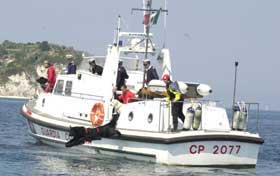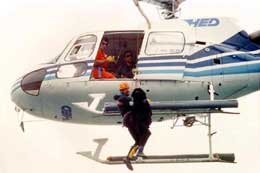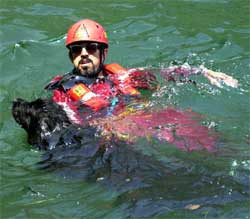|
THE COURSES OBEDIENCE ON THE GROUND FIRST LEVEL COURSE – It is used for socialising with the puppies as well as finding out which dogs have a suitable character for the work. If they do not reach the required standard the dog’s behaviour will have improved. The dog handlers are taught how to manage and solve the inevitable daily problems. The school instructors pay great care to teach the owner how to work the dog calmly and with knowledge once back at home. The course is maintained all the year round, even in the cold months, in order to reach the aim of having the dogs fully obedient when water courses start. The best time to start training is when the dogs are four months old , however older dogs can be admitted, even those a little older, most bad habits can be improved or eliminated.
DYNAMIC COURSE – To learn how to control the dog on ground work in safe conditions. The self control techniques learnt at the advanced course help improve the team spirit between handler and dog.
WATER WORK COURSE FIRST LEVEL – This course teaches how to have a calm and safe dog at the side of the handler in the water, avoiding being scratched by it whilst swimming. The dog will learn to work with or without the handler beside him. The puppies gain confidence in the new element slowly, they are never forced or frightened at this point of the training. In this phase the school motto is “we are playing”. The puppies must: learn to fully trust their two legged friend in these new conditions, gain confidence in the water and get acquainted with the equipment that they will use later on for service. Again it is fundamental not to rush the training; thoroughness is the order of the day, short cuts can never be taken. This is absolutely necessary for timid or difficult dogs. Once the first phases are over, you have an incredible feeling of team spirit when swimming at the side of your dog, in complete harmony, conscious of its power and safety.
WORKING COURSE In this course there is no time for play on the part of the dog. Swimming techniques and transport of the injured people will be improved. Medical instructions and first aid will be given. Both handler and dog will be stretched to their physical limits. Techniques for diving from wharf, pier, survey boat etc. will be taught. Dogs and handlers will be gradually introduced to Port Authorities, Police, Finance, and SAR. At this time you will discover that, having a dog as a friend, is worthwhile in all situations. If you want to know more, come to one of our demonstrations of Civil Protection. INSTRUCTORS COURSES Having completed the above courses it is possible to go to the headquarters of the school where there are yearly courses of theory and practice for the training to become an instructor. This consists of dog psychology, medicine, veterinary, civil protection etc. On passing the examination, at the end of the courses, a diploma will be given. At first you become an Assistant Instructor, then, after six months of practice at the school and the preparation of a thesis, it will be possible to become an Instructor. The school and instructors are at your disposal to prepare you for international sports certificates, accepted in Switzerland, France and Italy. FROM OBEDIENCE ON THE GROUND TO THE ADVANCED COURSES A course for each kind of dog and each type of owner. This is what is required to become a perfect team.
We can easily understand, from the words of Ferruccio Pilenga that the dog training school for water rescue is an institution opened to everyone. It might look strange that a school where such a complex function as water rescue is taught, is accepting untrained dogs and owners. This is explained if we look at the long list of courses that are run every year. It is possible to work on dogs that may never work in water rescue. We have three courses of obedience on the ground. From first level, where we face the first approach between man and animal, to the dynamic course during which the dog acquires the self-control, that gives the possibility of operating independently, without a leash, among the crowd. The best age to start learning this phase of work is of course as a puppy of approximately four months old; in any case older dogs can participate as it is always possible, even with some difficulty, to correct bad behaviours. Whether they are puppies or adult dogs, the animals which pass this first stage can be advanced to water work. The first level course starts as play teaching the dog that water is an element that it enjoys. Once it gets familiar with the water, the dog will learn to swim beside its handler without scratching him. This is an indispensable step to approach the advanced course, after which you and your animal will acquire the qualification certificate. Now, you are qualified to be available for rescue on beaches. After this there are still possibilities of attending a large range of working courses. These are designed to further improve your techniques for jumping from helicopters, diving from survey boats and anything necessary once you are in service on any of the Coast Guard facilities. Good results are obtained by working directly with your dog, never forcing it or asking more than it is capable of, but developing its strength and ability gradually as you and it are trained. This starts for the dog as play but gradually changes to work as the dog starts to enjoy it. Short cuts should never be attempted as this does not give confidence in the dog or the dog confidence in you. |


